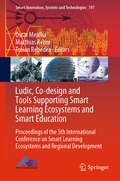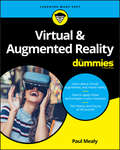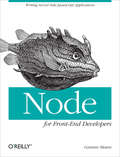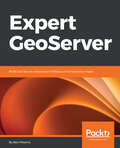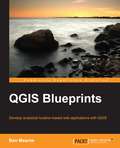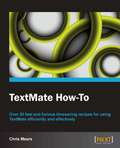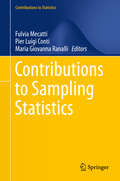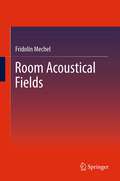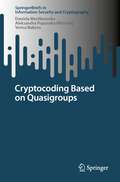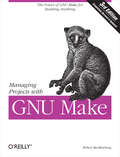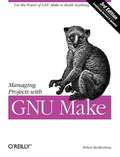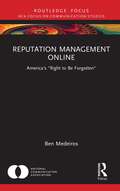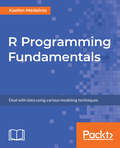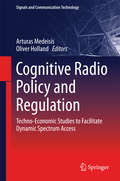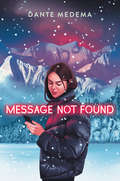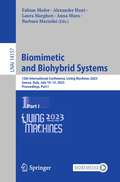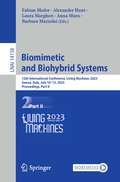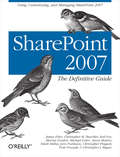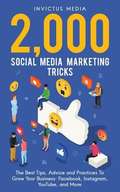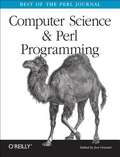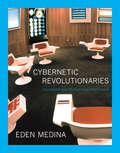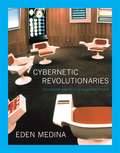- Table View
- List View
Ludic, Co-design and Tools Supporting Smart Learning Ecosystems and Smart Education: Proceedings of the 5th International Conference on Smart Learning Ecosystems and Regional Development (Smart Innovation, Systems and Technologies #197)
by Óscar Mealha Matthias Rehm Traian RebedeaThis book presents papers from the 5th International Conference on Smart Learning Ecosystems and Regional Development, which promotes discussions on R&D work, policies, case studies, entrepreneur experiences, with a particular focus on understanding the relevance of smart learning ecosystems for regional development and social innovation, and how the effectiveness of the relation of citizens and smart ecosystems can be boosted. The book explores how technology-mediated instruments can foster citizens’ engagement with learning ecosystems and territories, providing insights into innovative human-centric design and development models/techniques, education/training practices, informal social learning, innovative citizen-driven policies, and technology-mediated experiences and their impact. As such, it will inspire the social innovation sectors and ICT, as well as economic development and deployment strategies and new policies for smarter proactive citizens.
Virtual & Augmented Reality For Dummies
by Paul MealyAn easy-to-understand primer on Virtual Reality and Augmented Reality Virtual Reality (VR) and Augmented Reality (AR) are driving the next technological revolution. If you want to get in on the action, this book helps you understand what these technologies are, their history, how they’re being used, and how they’ll affect consumers both personally and professionally in the very near future. With VR and AR poised to become mainstream within the next few years, an accessible book to bring users up to speed on the subject is sorely needed—and that’s where this handy reference comes in! Rather than focusing on a specific piece of hardware (HTC Vive, Oculus Rift, iOS ARKit) or software (Unity, Unreal Engine), Virtual & Augmented Reality For Dummies offers a broad look at both VR and AR, giving you a bird’s eye view of what you can expect as they continue to take the world by storm. * Keeps you up-to-date on the pulse of this fast-changing technology * Explores the many ways AR/VR are being used in fields such as healthcare, education, and entertainment * Includes interviews with designers, developers, and technologists currently working in the fields of VR and AR Perfect for both potential content creators and content consumers, this book will change the way you approach and contribute to these emerging technologies.
Node for Front-End Developers
by Garann MeansIf you know how to use JavaScript in the browser, you already have the skills you need to put JavaScript to work on back-end servers with Node. This hands-on book shows you how to use this popular JavaScript platform to create simple server applications, communicate with the client, build dynamic pages, work with data, and tackle other tasks. Although Node has a complete library of developer-contributed modules to automate server-side development, this book will show you how to program with Node on your own, so you truly understand the platform. Discover firsthand how well Node works as a web server, and how easy it is to learn and use. Set up Node and learn how to build scaffolding for a web application Work with Node natively to see how it functions as a web server Understand how Node receives client data from GET and POST requests Use the Socket.IO module to facilitate realtime client-server communication Choose from among several Node templates to create dynamic pages Learn how to connect to a database, and store data in files Implement the Model-View-Controller pattern, and share Node modules with server and client
Node for Front-End Developers: Writing Server-Side JavaScript Applications
by Garann MeansIf you know how to use JavaScript in the browser, you already have the skills you need to put JavaScript to work on back-end servers with Node. This hands-on book shows you how to use this popular JavaScript platform to create simple server applications, communicate with the client, build dynamic pages, work with data, and tackle other tasks.Although Node has a complete library of developer-contributed modules to automate server-side development, this book will show you how to program with Node on your own, so you truly understand the platform. Discover firsthand how well Node works as a web server, and how easy it is to learn and use.Set up Node and learn how to build scaffolding for a web applicationWork with Node natively to see how it functions as a web serverUnderstand how Node receives client data from GET and POST requestsUse the Socket.IO module to facilitate realtime client-server communicationChoose from among several Node templates to create dynamic pagesLearn how to connect to a database, and store data in filesImplement the Model-View-Controller pattern, and share Node modules with server and client
Expert GeoServer: Build and secure advanced interfaces and interactive maps
by Ben MearnsA fast-paced guide to putting your GeoServer-based application into fast, user-friendly, and secure productionKey Features Resolve bottlenecks, optimize data stores, and cluster server resources Use identity management and authentication for a user-specific, secure web application Go beyond traditional web hosting to explore the full range of hosting options in the cloudBook DescriptionGeoServer is open source, server-side software written in Java that allows users to share and edit geospatial data. In this book, you'll start by learning how to develop a spatial analysis platform with web processing services. Then you'll see how to develop an algorithm by chaining together geospatial analysis processes, which you can share with anyone in the world. Next you'll delve into a very important technique to improve the speed of your map application—tile caching. Here, you'll understand how tile caching works, how to develop an effective tile cache-supported web service, and how to leverage tile caching in your OpenLayers web application.Further on, you'll explore important tweaks to produce a performant GeoServer-backed web mapping application. Moving on, you'll enable authentication on the frontend and backend to protect sensitive map data, and deliver sensitive data to your end user. Finally, you'll see how to put your web application into production in a secure and user-friendly way. You'll go beyond traditional web hosting to explore the full range of hosting options in the cloud, and maintain a reliable server instance.What you will learn Develop a WPS-processing service to allow web-based geospatial data processing Get to know important techniques to improve the speed of your web map application—tile caching, raster data optimization, and server clustering Find out which GeoServer settings resolve bottlenecks Develop an algorithm by chaining geospatial analysis processes together Put your application into production with hosting, monitoring, and automated backup and recovery Understand how to develop an effective tile cache-supported web service Master techniques that ensure resilient server deploymentWho this book is forThis book is for anyone who wants to learn about advanced interfaces, security, and troubleshooting techniques in GeoServer. A basic understanding of GeoServer is required
QGIS Blueprints
by Ben MearnsDevelop analytical location-based web applications with QGIS About This Book * Tame geographic information workflows with QGIS blueprints for smart web applications * Create geographic web applications using QGIS and free/open source software * Blueprints provide real-world applications covering many use cases Who This Book Is For This book encompasses relatively experienced GIS developers who have a strong grounding in the fundamentals of GIS development. They will have used QGIS before, but are looking to understand how to develop more complex, layered map applications that expose various data sets, utilize different visualizations, and are consumable (usable) by end users What You Will Learn * Review geographic information principles and the application of these principles in the QGIS free/open source ecosystem * Perform advanced analysis with site selection, hydrologic, and topological networks * Build performant web applications by tile caching and generating static assets * Provide collaborative editing capabilities for your team or community * Develop custom and dynamic analysis and visualization capabilities * Select the best components from desktop and web, for your use case * Integrate it with social media and crowdsourcing In Detail QGIS, the world's most popular free/open source desktop geographic information system software, enables a wide variety of use cases involving location - previously only available through expensive specialized commercial software. However, designing and executing a multi-tiered project from scratch on this complex ecosystem remains a significant challenge. This book starts with a primer on QGIS and closely related data, software, and systems. We'll guide you through six use-case blueprints for geographic web applications. Each blueprint boils down a complex workflow into steps you can follow to reduce time lost to trial and error. By the end of this book readers should be able to build complex layered applications that visualize multiple data sets, employing different types of visualization, and give end users the ability to interact with and manipulate this data for the purpose of analysis. Style and approach This is a comprehensive guide to the application of QGIS and free/open source software in creating web applications from analysis. Step-by-step blueprints guide the reader through analytical and web development topics and designs.
TextMate How-to
by Chris Mears"TextMate How-to" address essential tasks through recipes to hit the ground running and get started with practical solutions to common questions This book is geared toward beginning and intermediate web developers and designers who want to expedite their coding. Though TextMate can also work very well as a plain text editor, some experience with a programming or scripting language whether it's HTML, CSS, PHP, or Ruby is helpful to understand the depth to some of the examples provided.
Contributions to Sampling Statistics (Contributions to Statistics)
by Fulvia Mecatti Pier Luigi Conti Maria Giovanna RanalliThis book contains a selection of the papers presented at the ITACOSM 2013 Conference, held in Milan in June 2013 It is intended as an international forum of scientific discussion on the developments of theory and application of survey sampling methodologies and applications in human and natural sciences. The book gathers research papers carefully selected from both invited and contributed sessions of the conference. The whole book appears to be a relevant contribution to various key aspects of sampling methodology and techniques; it deals with some hot topics in sampling theory, such as calibration, quantile-regression and multiple frame surveys and with innovative methodologies in important topics of both sampling theory and applications Contributions cut across current sampling methodologies such as interval estimation for complex samples, randomized responses, bootstrap, weighting, modeling, imputation, small area estimation and effective use of auxiliary information; applications cover a wide and enlarging range of subjects in official household surveys, Bayesian networks, auditing, business and economic surveys, geostatistics and agricultural statistics. The book is an updated, high level reference survey addressed to researchers, professionals and practitioners in many fields.
Room Acoustical Fields
by Fridolin MechelThis book presents the theory of room acoustical fields and revises the Mirror Source Methods for practical computational use, emphasizing the wave character of acoustical fields. The presented higher methods include the concepts of "Mirror Point Sources" and "Corner sources which allow for an excellent approximation of complex room geometries and even equipped rooms. In contrast to classical description, this book extends the theory of sound fields describing them by their complex sound pressure and the particle velocity. This approach enables accurate descriptions of interference and absorption phenomena.
Cryptocoding Based on Quasigroups (SpringerBriefs in Information Security and Cryptography)
by Daniela Mechkaroska Aleksandra Popovska-Mitrovikj Verica BakevaThis book presents the concept of cryptcoding which arises from the need to obtain secure and accurate transmission. Therefore, it is necessary to improve constantly existing and develop new algorithms that will ensure accurate and secure data transfer. This leads to the intensive development of coding theory and cryptography as scientific fields which solve these problems. To ensure efficient and secure data transmission at the same time, the concept of cryptcoding is developed such that the coding and encryption processes are merged into one process. Cryptcodes provide correction of a certain number of errors in the transmitted message and data confidentiality, using only one algorithm. The main research in this field is to define new algorithms for coding that detects and corrects errors, random codes, stream ciphers, block ciphers, pseudo-random generators, hash functions, etc. This monograph examines an application of quasigroups for designing error-correcting cryptcodes, called Random Codes Based on Quasigroups (RCBQ ). These codes are a combination of cryptographic algorithms and error-correcting codes and depend on several parameters. Some modifications (new coding/decoding algorithms) of RCBQ for improving their performances for transmission ordinary messages, images, and audio files trough a binary-symmetric channel, Gaussian channel, and burst channels are considered. Also, authors propose and analyze filter for visually enhance of the decoded images and improving the quality of decoded audio files.
Produktdatenmanagement – Anforderungen und Lösungen: Konzeption, Auswahl, Installation und Administration von PDM-Systemen
by Thomas MechlinskiProduktdatenmanagement (PDM) ist ein umfassendes, in seiner Ganzheit schwer zu überblickendes Thema. Bei der Betrachtung gängiger PDM-Systeme stellt sich oft die Frage, warum bestimmte Funktionen und Eigenschaften existieren und wie sich damit typische Fragestellungen des Produktentstehungsprozesses (PEP) lösen lassen. Dieses Buch formuliert Anforderungen, die die heute am Markt erhältlichen PDM-Systeme abdecken und erklärt, auf welche Weise die Anforderungen erfüllt werden können. Der Katalog an Anforderungen ist auf die industrielle Praxis im Umfeld der Serienfertigung von Produkten zugeschnitten und kann auch als Basis für die Einführung von PDM-Systemen genutzt werden.Das Buch richtet sich an IT-Verantwortliche, die sich mit der Einführung oder dem Ausbau von PDM-Systemen beschäftigen. Es ist solchermaßen detailliert, dass die Anforderungen und Lösungen in Bezug auf einen konkreten Einsatz beurteilt werden können. Die beschriebenen Lösungsansätze können für die Implementierung in einem Unternehmen übernommen und bedarfsgerecht verändert oder ausgebaut werden. Der Ansatz ist so gewählt, dass dieses Buch auch für Studierende als Basis für das Verständnis von PDM-Systemen dienen kann.
Managing Projects with GNU Make
by Robert MecklenburgThe utility simply known as make is one of the most enduring features of both Unix and other operating systems. First invented in the 1970s, make still turns up to this day as the central engine in most programming projects; it even builds the Linux kernel. In the third edition of the classic Managing Projects with GNU make, readers will learn why this utility continues to hold its top position in project build software, despite many younger competitors. The premise behind make is simple: after you change source files and want to rebuild your program or other output files, make checks timestamps to see what has changed and rebuilds just what you need, without wasting time rebuilding other files. But on top of this simple principle, make layers a rich collection of options that lets you manipulate multiple directories, build different versions of programs for different platforms, and customize your builds in other ways. This edition focuses on the GNU version of make, which has deservedly become the industry standard. GNU make contains powerful extensions that are explored in this book. It is also popular because it is free software and provides a version for almost every platform, including a version for Microsoft Windows as part of the free Cygwin project. Managing Projects with GNU make, 3rd Edition provides guidelines on meeting the needs of large, modern projects. Also added are a number of interesting advanced topics such as portability, parallelism, and use with Java. Robert Mecklenburg, author of the third edition, has used make for decades with a variety of platforms and languages. In this book he zealously lays forth how to get your builds to be as efficient as possible, reduce maintenance, avoid errors, and thoroughly understand what make is doing. Chapters on C++ and Java provide makefile entries optimized for projects in those languages. The author even includes a discussion of the makefile used to build the book.
Managing Projects with GNU Make, 3rd Edition
by Robert MecklenburgThe utility simply known as make is one of the most enduring features of both Unix and other operating systems. First invented in the 1970s, make still turns up to this day as the central engine in most programming projects; it even builds the Linux kernel. In the third edition of the classic Managing Projects with GNU make , readers will learn why this utility continues to hold its top position in project build software, despite many younger competitors. The premise behind make is simple: after you change source files and want to rebuild your program or other output files, make checks timestamps to see what has changed and rebuilds just what you need, without wasting time rebuilding other files. But on top of this simple principle, make layers a rich collection of options that lets you manipulate multiple directories, build different versions of programs for different platforms, and customize your builds in other ways. This edition focuses on the GNU version of make , which has deservedly become the industry standard. GNU make contains powerful extensions that are explored in this book. It is also popular because it is free software and provides a version for almost every platform, including a version for Microsoft Windows as part of the free Cygwin project. Managing Projects with GNU make , 3rd Edition provides guidelines on meeting the needs of large, modern projects. Also added are a number of interesting advanced topics such as portability, parallelism, and use with Java. Robert Mecklenburg, author of the third edition, has used make for decades with a variety of platforms and languages. In this book he zealously lays forth how to get your builds to be as efficient as possible, reduce maintenance, avoid errors, and thoroughly understand what make is doing. Chapters on C++ and Java provide makefile entries optimized for projects in those languages. The author even includes a discussion of the makefile used to build the book.
Reputation Management Online: America's "Right to Be Forgotten" (NCA Focus on Communication Studies)
by Ben MedeirosThis book examines the work of the public relations, technology, and legal professionals who provide online "reputation management" services, situating their work within contemporary debates about regulating speech on the internet. The author argues that legal solutions like the European "Right to Be Forgotten" are not really possible in the U.S., but that the private solutions of reputation management help to ameliorate novel concerns about reputation. At the same time, he contends that these practices prompt different free speech and dignitary concerns unique to the digital environment. Drawing upon rhetorical and legal analysis of diverse texts, including reputation management promotional materials, interviews with practitioners, legal cases, and popular online commentary about reputational disputes themselves, the book intervenes in specific debates about the regulation of the internet, as well as broader socio-legal debates about the role of reputation-damaging speech in a democratic society. This timely and relevant study will have great relevance for all students and scholars of communication studies, public relations, rhetoric, new and digital media, internet law, technology and society, computer mediated communication, and sociology.
R Programming Fundamentals: Deal with data using various modeling techniques
by Kaelen MedeirosStudy data analysis and visualization to successfully analyze data with RKey FeaturesGet to grips with data cleaning methodsExplore statistical concepts and programming in R, including best practicesBuild a data science project with real-world examplesBook DescriptionR Programming Fundamentals, focused on R and the R ecosystem, introduces you to the tools for working with data. To start with, you’ll understand you how to set up R and RStudio, followed by exploring R packages, functions, data structures, control flow, and loops.Once you have grasped the basics, you’ll move on to studying data visualization and graphics. You’ll learn how to build statistical and advanced plots using the powerful ggplot2 library. In addition to this, you’ll discover data management concepts such as factoring, pivoting, aggregating, merging, and dealing with missing values.By the end of this book, you’ll have completed an entire data science project of your own for your portfolio or blog.What you will learnUse basic programming concepts of R such as loading packages, arithmetic functions, data structures, and flow controlImport data to R from various formats such as CSV, Excel, and SQLClean data by handling missing values and standardizing fieldsPerform univariate and bivariate analysis using ggplot2Create statistical summary and advanced plots such as histograms, scatter plots, box plots, and interaction plotsApply data management techniques, such as factoring, pivoting, aggregating, merging, and dealing with missing values, on the example datasetsWho this book is forR Programming Fundamentals is for you if you are an analyst who wants to grow in the field of data science and explore the latest tools.
Cognitive Radio Policy and Regulation: Techno-Economic Studies to Facilitate Dynamic Spectrum Access (Signals and Communication Technology)
by Arturas Medeisis Oliver HollandThis book offers a timely reflection on how the proliferation of advanced wireless communications technologies, particularly cognitive radio (CR) can be enabled by thoroughly-considered policy and appropriate regulation. It looks at the prospects of CR from the divergent standpoints of technological development and economic market reality. The book provides a broad survey of various techno-economic and policy aspects of CR development and provides the reader with an understanding of the complexities involved as well as a toolbox of possible solutions to enable the evolutionary leap towards successful implementation of disruptive CR technology or indeed any other novel wireless technologies. Cognitive Radio Policy and Regulation showcases the original ideas and concepts introduced into the field of CR and dynamic spectrum access policy over nearly four years of work within COST Action IC0905 TERRA, a think-tank with participants from more than 20 countries. The book's subject matter includes: * deployment scenarios for CR; * technical approaches for improved spectrum sharing; * economic aspects of CR policy and regulation; * impact assessment of cognitive and software-defined radio; and * novel approaches to spectrum policy and regulation for the age of CR. The book will interest researchers in the field of wireless communications, especially those working with standardization and policy issues, as well as industry and regulatory professionals concerned with radio spectrum management and the general development of wireless communications. Considerable complementary reference material such as power point slides and technical reports that illustrates and expands on the contents of the book is provided on the companion website to the book, found at http://www. cost-terra. org/CR-policy-book
Message Not Found
by Dante MedemaAn emotionally complex portrayal of secrets, loss, and grief from Dante Medema, Indies Introduce author of the Indie Next Pick title The Truth Project. Bailey and Vanessa shared everything: laughter, secrets, and packets of Pop Rocks to ward off bad days. But that all changed the night Vanessa left Bailey’s, headed for home, and ended up swerving off a cliff nowhere near her house. Now Bailey, who thought she knew Vanessa better than anyone in the world, is left with a million unanswered questions, and the only person with answers is gone.To help grieve her loss, Bailey creates a chat bot of Vanessa using years’ worth of their shared text messages and emails. The more data she uploads to the bot, the more it feels like she’s really talking to her best friend. That is, until the bot starts dropping hints that there was more going on with Vanessa than Bailey realized—a secret so big, it may have contributed to Vanessa’s death.This compelling puzzle of a story, filled with engrossing twists and turns, is written in alternating prose and text message formats. Teens will gobble up this fast-paced page-turner.
Biomimetic and Biohybrid Systems: 12th International Conference, Living Machines 2023, Genoa, Italy, July 10–13, 2023, Proceedings, Part I (Lecture Notes in Computer Science #14157)
by Fabian Meder Alexander Hunt Laura Margheri Anna Mura Barbara MazzolaiThis book constitutes the proceedings of the 12th International Conference on Biomimetic and Biohybrid Systems, Living Machines 2022, in Genoa, Italy, held in July 19–22, 2022.The 44 full papers and 14 short papers presented were carefully reviewed and selected from 67 submissions. They deal with research on novel life-like technologies inspired by the scientific investigation of biological systems, biomimetics, and research that seeks to interface biological and artificial systems to create biohybrid systems. The conference aims to highlight the most exciting research in both fields united by the theme of “Living Machines.”
Biomimetic and Biohybrid Systems: 12th International Conference, Living Machines 2023, Genoa, Italy, July 10–13, 2023, Proceedings, Part II (Lecture Notes in Computer Science #14158)
by Fabian Meder Alexander Hunt Laura Margheri Anna Mura Barbara MazzolaiThis book constitutes the proceedings of the 12th International Conference on Biomimetic and Biohybrid Systems, Living Machines 2022, in Genoa, Italy, held in July 19–22, 2022. The 44 full papers and 14 short papers presented were carefully reviewed and selected from 67 submissions. They deal with research on novel life-like technologies inspired by the scientific investigation of biological systems, biomimetics, and research that seeks to interface biological and artificial systems to create biohybrid systems. The conference aims to highlight the most exciting research in both fields united by the theme of “Living Machines.”
SharePoint 2007: The Definitive Guide
by Jason Medero Michael Lotter Piotr Prussak Nilesh Mehta Murray Gordon Christopher Pragash Bob Fox James Pyles Joris Poelmans Christopher J. Regan Christopher M. BuechlerFor any organization that wants to use Windows SharePoint Services to share and collaborate on Microsoft Office documents, this book shows administrators of all levels how to get up and running with this powerful and popular set of collaboration tools. Microsoft Windows SharePoint Services technology in Office 2007 is an integrated set of services designed to connect people, information, processes, and systems both within and beyond the organizational firewall. SharePoint 2007: The Definitive Guide provides a detailed discussion of all Sharepoint features, applications and extensions. You learn how to build Sharepoint sites and site collections, along with ways to administrate, secure, and extend Sharepoint. This book teaches you how to: Get up to speed on SharePoint, including ways to create lists, libraries, discussions and surveys Integrate email, use web parts, track changes with RSS, and use database reporting services Customize your personal site, create sites and areas, and organize site collections Integrate with Office applications, including Excel, Word, Outlook, Picture Manager, and InfoPath Install, deploy, maintain and secure SharePoint Brand a portal, using your corporate style sheet, designing templates, and building site definitions Extend SitePoint, such as creating client side and server side web parts, using the SharePoint class library and SharePoint web services Each chapter starts with a "guide" that lets you know what it covers before you dive in. The book also features a detailed reference section that includes information on compatibility, command line utilities, services, and CSS styles. Why wait? Get a hold of SharePoint 2007: The Definitive Guide today!
2000 Social Media Marketing Tricks: The Best Tips, Advice And Practices To Grow Your Business: Facebook, Instagram, Youtube, And More
by Invictus MediaIf you're looking to grow your business bigger and faster than you ever imagined possible, using a step-by-step guide on how to utilize social media marketing....THIS BOOK IS FOR YOU! <p><p> "2000 SOCIAL MEDIA MARKETING TRICKS" is a title of more than just tips and tricks you can apply to social media platforms - it is a DONE WITH YOU guide to ensure your growing success on the current hottest platforms out there - Facebook, Instagram, Youtube, and others! <p> Don't waste another day wondering when is the perfect time to join in on the social media frenzy. Start taking your business to the next level and purchase your copy today.
Computer Science & Perl Programming
by O'Reilly MediaIn its first five years of existence, The Perl Journal ran 247 articles by over 120 authors. Every serious Perl programmer subscribed to it, and every notable Perl guru jumped at the opportunity to write for it. TPJ explained critical topics such as regular expressions, databases, and object-oriented programming, and demonstrated Perl's utility for fields as diverse as astronomy, biology, economics, AI, and games. The magazine gave birth to both the Obfuscated Perl Contest and the Perl Poetry contest, and remains a proud and timeless achievement of Perl during one of its most exciting periods of development. Computer Science and Perl Programming is the first volume of The Best of the Perl Journal, compiled and re-edited by the original editor and publisher of The Perl Journal, Jon Orwant. In this series, we've taken the very best (and still relevant) articles published in TPJ over its 5 years of publication and immortalized them into three volumes. This volume has 70 articles devoted to hard-core computer science, advanced programming techniques, and the underlying mechanics of Perl. Here's a sample of what you'll find inside: Jeffrey Friedl on Understanding Regexes Mark Jason Dominus on optimizing your Perl programs with Memorization Damian Conway on Parsing Tim Meadowcroft on integrating Perl with Microsoft Office Larry Wall on the culture of Perl Written by 41 of the most prominent and prolific members of the closely-knit Perl community, this anthology does what no other book can, giving unique insight into the real-life applications and powerful techniques made possible by Perl. Other books tell you how to use Perl, but this book goes far beyond that: it shows you not only how to use Perl, but what you could use Perl *for*. This is more than just The Best of the Perl Journal -- in many ways, this is the best of Perl.
Cybernetic Revolutionaries: Technology and Politics in Allende's Chile
by Eden MedinaA historical study of Chile's twin experiments with cybernetics and socialism, and what they tell us about the relationship of technology and politics.In Cybernetic Revolutionaries, Eden Medina tells the history of two intersecting utopian visions, one political and one technological. The first was Chile's experiment with peaceful socialist change under Salvador Allende; the second was the simultaneous attempt to build a computer system that would manage Chile's economy. Neither vision was fully realized—Allende's government ended with a violent military coup; the system, known as Project Cybersyn, was never completely implemented—but they hold lessons for today about the relationship between technology and politics.Drawing on extensive archival material and interviews, Medina examines the cybernetic system envisioned by the Chilean government—which was to feature holistic system design, decentralized management, human-computer interaction, a national telex network, near real-time control of the growing industrial sector, and modeling the behavior of dynamic systems. She also describes, and documents with photographs, the network's Star Trek-like operations room, which featured swivel chairs with armrest control panels, a wall of screens displaying data, and flashing red lights to indicate economic emergencies.Studying project Cybersyn today helps us understand not only the technological ambitions of a government in the midst of political change but also the limitations of the Chilean revolution. This history further shows how human attempts to combine the political and the technological with the goal of creating a more just society can open new technological, intellectual, and political possibilities. Technologies, Medina writes, are historical texts; when we read them we are reading history.
Cybernetic Revolutionaries
by Eden MedinaIn Cybernetic Revolutionaries, Eden Medina tells the history of two intersecting utopian visions, one political and one technological. The first was Chile's experiment with peaceful socialist change under Salvador Allende; the second was the simultaneous attempt to build a computer system that would manage Chile's economy. Neither vision was fully realized--Allende's government ended with a violent military coup; the system, known as Project Cybersyn, was never completely implemented--but they hold lessons for today about the relationship between technology and politics. Drawing on extensive archival material and interviews, Medina examines the cybernetic system envisioned by the Chilean government--which was to feature holistic system design, decentralized management, human-computer interaction, a national telex network, near real-time control of the growing industrial sector, and modeling the behavior of dynamic systems. She also describes, and documents with photographs, the network's Star Trek-like operations room, which featured swivel chairs with armrest control panels, a wall of screens displaying data, and flashing red lights to indicate economic emergencies. Studying project Cybersyn today helps us understand not only the technological ambitions of a government in the midst of political change but also the limitations of the Chilean revolution. This history further shows how human attempts to combine the political and the technological with the goal of creating a more just society can open new technological, intellectual, and political possibilities. Technologies, Medina writes, are historical texts; when we read them we are reading history.
